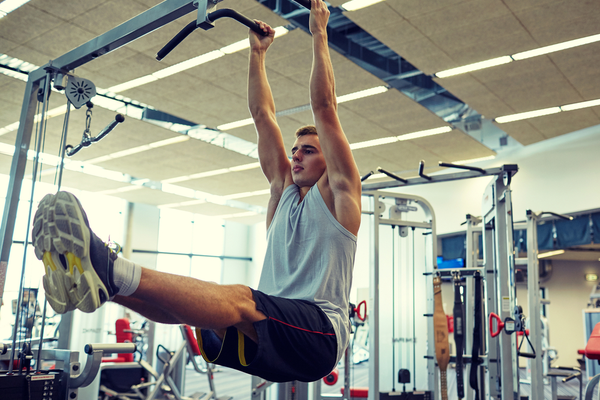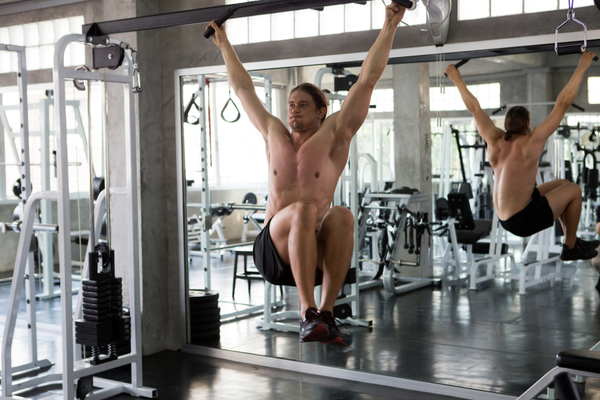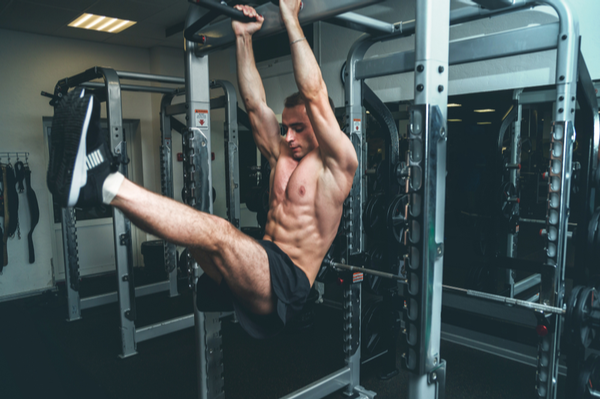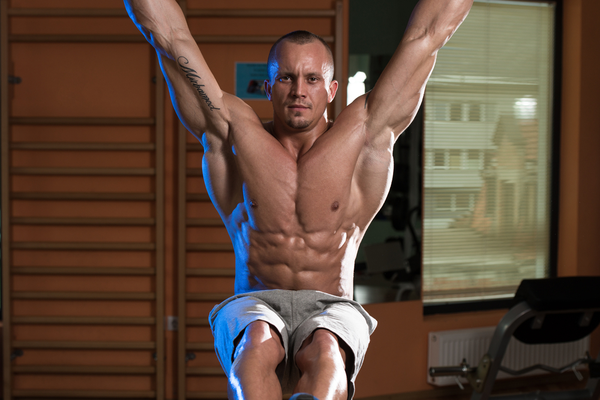How To Do Hanging Leg Raises To Increase Functional Strength

Hanging leg raises are one of the isolated exercises that work on your abdominal muscles. If you want that perfect six-pack ab, with a stronger lower body then hanging leg raise is an ideal workout for you. According to many fitness experts, hanging legs is an expert level of workout where muscles contract even without movement. It is uncomfortable yet a superstar workout that helps to build strength and activate major muscle groups.
Hanging leg raises puts your lower abs and hip flexors against gravity and stabilizes lats and forearm muscles. Exercises like situps crunch mainly target your upper abs but the lower abs also need to be in focus. That's where hanging legs raises come into the picture. Not many people give importance and know the power of this exercise. It keeps your legs continuously engaged to your entire abdomen. Let us look at how to do hanging leg raises with many variations.
How to do Hanging Leg Raises

To do this kind of workout, you need to have a chin-up round-shaped high bar. The bar should be stable and have a strong foundation that can handle your body weight. The height of the bar should be well adjusted so that you can raise your legs with ease.
- Hold the bar over your head with a strong overhand grip.
- Move your pelvis slightly backward. By hanging on the bar, lift your feet above the ground and raise your legs straight in front of you.
- Breathe out when you lift your legs. You should feel that your abdominal muscles are getting engaged to your abs.
- Your raised legs position should be parallel to the ground. Bend your hips at a 90-degree angle.
- Inhale and then bring your leg back to the initial position. Do 30 reps of this movement.
See also: Health Benefits of Sitting Poses for Developing your Mind and Body
Hanging Leg Raises Variations
Legs Knee Raises

It is just a standard version of hanging leg raise, but you have to bend your knees when you lift above the ground. This variation is slightly tough and will require stamina and good balance.
Hanging Knee Twist

Initially, you have to be in a hanging knee raise position. Then tuck your knees till your chest and tilt on the right side. Then come back to the center and change the position by tucking your knees towards the left side. Repeat this movement 2-3 times. Perform this variation slowly and don't rush.
Hanging V Sit

When you are in the hanging leg raise position, slowly raise your legs together in the upward direction. The whole position should look like you are forming a V with your abdomen and legs. Look at your raised legs at the top. Slowly lower your legs and bring them back to the normal position.
See also: How to Master Rack Pulls to Achieve a Perfect Body
Common Mistakes
- Don't swing on the bar. Avoid it. When you raise your legs, focus on your hip flexors and abs, don't sway your body.
- You can keep your shoulders a little hunched if you are a beginner but once you master it, try to keep your back straight throughout the exercise to avoid back strain.
- Don't lower your legs too quickly. Instead, bring down your legs slowly only after you keep them raised for a certain period. Otherwise, you will not get much benefit from this exercise.
Benefits

- Sartorius and the iliopsoas are the hip flexor muscles that work very hard to strengthen your abdominal muscles. A high level of ab trainers do this workout in their routine.
- It is an effective exercise to build your core strength, grip and forearm strength.
- It helps to improve your shoulder flexibility and mobility.
- If your arms, shoulders and wrist were tightened for some kind of frequent physical work, then hanging leg raise helps to improve the elasticity of your body.
- Because of the hanging position, your discs, muscles and tendons with lengthen and relax. Furthermore, it is a perfect choice for those who are suffering from back pain.
If you are looking for a way to strengthen your core, you might have heard about hanging leg raises. This is a great exercise that will help you massage your hip flexors, target your abs, and even strengthen your quads. How do you perform this exercise, and how can you get the most out of it?
Why Do Them: What Are Hanging Leg Raises?
During hanging leg raises, you will start in a free hanging position from a bar, similar to a pull-up. Then, you will lift your legs, keeping them parallel to the ground and straight. You will raise your legs slowly from the ground, and then lower them once again. Even if you cannot raise your legs fully, you will still give your abs a great workout. The goal is to keep your body straight during this process, performing an exceptional isometric movement with your abs.
This is a great exercise that will place your abs and hip flexors in a disadvantageous position against gravity. By forcing these muscles to battle gravity, you will strengthen and stabilize those muscle groups. In addition, you will also target your lats (which are in the lower and middle back) as well as your forearms (which are responsible for gripping the bar during the workout).
Trainers’ Guide: How To Do Hanging Leg Raises
In order to perform hanging leg raises properly, there are several steps you need to follow. These include:
- 1. Find a sturdy, stable overhead bar. These are typically found in a gym; however, you can get one for your house as well. Remember that this bar has to support the entirety of your body weight.
- 2. Use an overhand grip to grab the bar. Allow your body to hang from the bar. Make sure the bar stays in place.
- 3. Fire your ab muscles. Lift your feet off the ground.
- 4. Keeping your legs straight, lift your legs to a 90-degree angle with the rest of your body. Exhale during this motion.
- 5. Hold your legs at a 90-degree angle for a few seconds.
- 6. Lower your legs back down to the ground slowly. Inhale during this motion.
Repeat this repetition several times to complete your ab workout.

Common Mistakes During Hanging Leg Raises
There are several common mistakes that people make during hanging leg raises. They include:
- Swinging the Legs: The goal is to use your abs to raise your legs. If you swing your legs and make the workout easier, you don’t get as much benefit. Lift your legs slowly.
- Dropping the Legs: When you lower your legs, you should do so slowly, providing resistance against gravity. That is where the exercise comes in. Don’t simply drop your legs.
- Bending the Knees: Do not bend your knees during the workout. While this might make the workout easier, it also removes stress from your abs, reducing the benefit of the exercise.
Avoid these common mistakes when you perform hanging leg raises.
The Benefits of Hanging Leg Raises
There are numerous benefits of performing hanging leg raises. These include:
- Build Core Strength: Of course, the biggest benefit of performing hanging leg raises is that you will be improving your core strength. You will isolate your abs and force them to fight against gravity to complete every repetition, which will drive the workout.
- Shoulder Stability: Next, hanging leg raises will increase your shoulder stability and mobility. Lots of people spend their days with their shoulders dangling by their sides. Therefore, you need to increase your shoulder mobility and stability by placing them in a hang position. While you will strengthen your shoulders, you also open up the joints with this exercise, giving them a chance to breathe.
- Back Pain: If you suffer from lower back pain, this is an exercise that can help you address this issue. In a free hang position, all joints get a chance to breathe and lengthen, which takes a lot of stress off your lower back. In this lengthened position, you can strengthen muscles in your lower back that are traditionally vulnerable, helping you address back pain.
These are just a few of the many benefits of performing hanging leg raises.
Variations of Hanging Leg Raises: Ski Exercises
There are several variations of hanging leg raises. A few basic variations include:
- Consider attaching weights to your feet to make the workout harder.
- You can lift your legs all the way up to your face and back down again for a slightly different exercise.
- You can also add a pull-up or chin-up during each repetition to make the exercise more challenging, adding more upper body to the routine.
Another popular variation is an exercise performed by professional skiers. This is weighted leg raises with a twist to engage additional muscles. To perform this exercise, you will:
- 1. Start in the same position. Grab the overhead bar.
- 2. Next, place a medicine ball between your legs. Hold the ball with your ankles.
- 3. Lift your body off the ground. Make sure your feet hold onto the medicine ball.
- 4. Perform your leg raise. Try to keep your legs as straight as possible. You might need to bend your knees slightly to keep the medicine ball from slipping. That is okay.
- 5. When you raise your legs, twist your legs from side to side with each repetition. This will engage your lower body, adding another level of control that targets the obliques.
This could be a way for you to take your hanging leg raises to a new level.
Alternative Exercises to Hanging Leg Raises
Hanging leg raises are a great way for you to target your core. There might be additional core workouts you want to try. A few examples include:
- Sit-ups and crunches
- Rollouts with an ab wheel
- Leg lifts and flutter kicks
- Planks and hollow holds
You may want to diversify your workouts to include these exercises. Make sure you get the most out of each rep.
Read Also:
How to Get Rid of a Hickey by Doing Some Quick Remedies
Drink Assam Tea to Enjoy the Rich Drink and Boost your Energy
ActiveMan — Make Your Move
The Modern Guide to Men’s Health, Fitness & Lifestyle.





